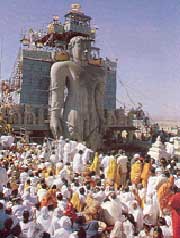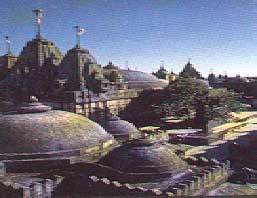Mahavira cannot be called the founder of Jainism rather its reformer. The first Jain prophet was Rsabha who is mentioned in the Vedas and hence Jainism can be considered to be of great antiquity. The Jains number a few millions in India and are predominantly found in the west and southwest.
They believe that the Universe is infinite. In Jainism, God as such does not exist. A liberated soul, that of a prophet is God. A voluntary death by penance is considered highly esteem. They also believe in reincarnation and eventual spiritual salvation or Moksha. One factor in the search for salvation is Ahimsa or reverence for all life and the avoidance of injury to all living things. Due to this belief the Jains are all vegetarians and some monks even cover their mouth with a piece of cloth actually to avoid the risk of accidentally swallowing an insect. They also walk in the streets with a tiny duster that clears their way of any tiny creatures that they might accidentally hurt!
The Jains are divided into two sects, the Shvetembara and the Digambara.The Digambaras are the more austere sect and as a sign of their contempt for material possessions they wear no clothes. Most of the Digambaras are monks and they confine their nudity within the monasteries. The famous Shravanbelagola temple in Karnataka is a Digambara temple.
A good Shvetambara Jain should vow to avoid injury, falsehood and theft. He is also supposed to make a pilgrimage to one of the sacred Tirthas, Mount Abu, Mount Samneta, and Mount Girnar near Junagadh and Mount Shatrunjaya near Palitana. The last one is very famous where a visit to the vast temple with more than 1000 Jain shrines and 800 mini temples is said to be meritorious as visiting all other hills combined.
Jain temples

SHRAVANABELAGOLA
TEMPLE
The Jains tend to be clever and commercially successful and have a great influence anywhere they move. They chiefly belong to the mercantile class spread mainly over central, eastern and southern India. There are many Jains in Rajasthan, Gujarat and Bombay. In general the Jains are self-effacing, neither giving money ostentatiously to the community nor lavishing it themselves. Health and education, such as hospitals, libraries and schools, are often their choice of patronage. They have set up many trusts and charitable institutions in India.

PALITANA TEMPLE
Jain temples are similar to the Hindu temples with the difference being in the number of cells built to hold the images. Many Jain temples hide their spectacular interiors behind non-descript walls. Most of the temples are aligned along an east-west axis. Temples may be either rock-cut or freestanding. The hilltop complex of Shatrunjaya, the Place of victory, in Gujarat is one of the most evocative Jain memorials in India. The Dilwara temples of Mt. Abu in Rajasthan are renowned as the country's finest Jain architecture. The Jain temple complex at Ranakpur in Rajasthan is one of the largest. With an area of 100 meters square, it has 29 halls supported by 1444 pillars.


